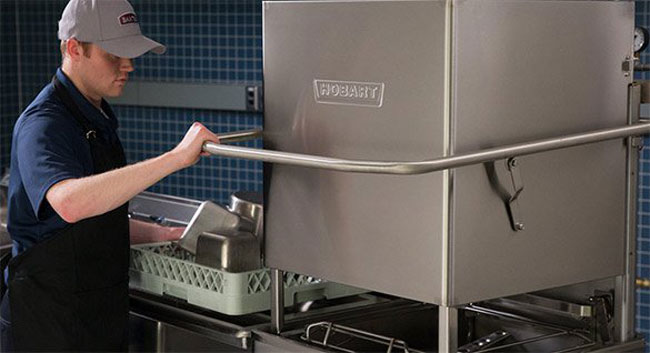From start to finish, every step in the process of dishwashing is critical to maintain food safety and efficient operation.
Proper dishroom operation is a combination of an effective machine and effective practices. Here are some “critical control points” from the experts to make your dishroom run more efficiently.
 Expert advice can help make your dishroom run more smoothly.
Expert advice can help make your dishroom run more smoothly.
 Operator
OperatorAll dishroom staff should be fully trained in both machine operations and food safety procedures. Wall charts and training videos from the manufacturer posted in the dishroom can be helpful. “Training of the operators is the most important thing. We even put a QR code on the machine so they can use their smartphone and go right to the video.” – Joel Hipp, Engineering Manager, Hobart Warewashing Division
 Prescraping
PrescrapingFor the most effective cleaning, large food particles and heavy food soil should be scraped off before dishes are placed in the machine to reduce the chance of rewash after a cycle. When dishes aren’t prescraped properly, “you could have pathogens within food debris that are still on the plates or utensils.” – Vito Palazzolo, Manager of Industry Relationships, National Restaurant Association
 Machine Operation
Machine OperationFor hot water-sanitizing machines, ensure that the water is at the correct temperature as noted in the manufacturer’s specifications. For all machines (high temp and chemical sanitizing), “make sure you’re using the right chemicals [at the right concentration] as recommended by the [chemical] manufacturer to get the desired results for cleaning and sanitation.” – Orsi Dèszi, Business Unit Manager, Food Equipment, NSF International
 Machine Cleaning
Machine CleaningDaily cleaning of the dishmachine not only helps ensure longer and better performance from the machine, it also helps reduce the chances of rewash and contamination. “When you spend a little bit of time on it every day versus once every few weeks, you’re going to get better results from the machine.” – Alan Risher, Sales Development Manager, Hobart Warewashing Division
 Storage of Clean Dishes
Storage of Clean DishesDishes and ware should be allowed to air dry completely after being washed and sanitized. They should never be dried off with a cloth or stacked before they are completely dry. “You’ve got a machine that’s certified to sanitize and now you’re possibly introducing a source of contamination back onto a dish that you’ve just sanitized.” – Michael Kohler, Associate Technical Director – Food Equipment, NSF
Learn more about Hobart commercial dishwashers at hobartcorp.com.



